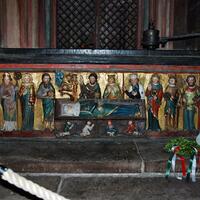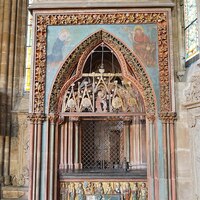Tomb of St. Elizabeth
Type:
Tombs
Date:
front panel ca. 1350
Location or Findspot (Modern-Day Country):
Germany
Description:
St. Elizabeth (1207–1231) was a Hungarian princess, widow of a German nobleman who died on crusade. Adopting a Franciscan life of piety and charity without formally joining that religious order, Elizabeth died while working at a leper hospital she had founded in Marburg (Germany). A series of miraculous healings at her tomb inspired a well-documented process of canonization that culminated in 1236, when her sainted remains were disinterred and placed on the high altar of a new triconch church dedicated to her in Marburg (the church was consecrated in 1283).
Elizabeth was a new type of saint unknown before the late Middle Ages: a layperson who had led an exemplary life. In 1249 her relics were moved to a golden reliquary shrine (her skull was given to the Holy Roman Emperor Frederick II, who expressed his support of the Franciscan movement by commissioning a separate reliquary). Elizabeth's newly sacred body inspired a popular cult promoted by Franciscans, Dominicans, Cistercians, and especially the Teutonic Order, to which her confessor belonged. These German knights protected Christians in the Holy Land and founded numerous hospitals, of which Elizabeth became the patron saint. Nevertheless, pilgrimage to Elizabeth's remains declined in the later thirteenth century as her remains were made less accessible by being placed in the north apse of the church, where they were viewed primarily by high-status visitors.
Erected around 1280 over her original burial site, the carved and painted tomb presents Elizabeth's radical poverty as a model of noble care for the poor. In a panel added to the front around 1350, she is shown at the moment of burial, watched by Christ and saints on a gilded background while disabled pilgrims approach her bier on the crutches and stools they will soon no longer need. Elizabeth's relics were removed from Marburg during the Protestant upheavals of the sixteenth century.
Elizabeth was a new type of saint unknown before the late Middle Ages: a layperson who had led an exemplary life. In 1249 her relics were moved to a golden reliquary shrine (her skull was given to the Holy Roman Emperor Frederick II, who expressed his support of the Franciscan movement by commissioning a separate reliquary). Elizabeth's newly sacred body inspired a popular cult promoted by Franciscans, Dominicans, Cistercians, and especially the Teutonic Order, to which her confessor belonged. These German knights protected Christians in the Holy Land and founded numerous hospitals, of which Elizabeth became the patron saint. Nevertheless, pilgrimage to Elizabeth's remains declined in the later thirteenth century as her remains were made less accessible by being placed in the north apse of the church, where they were viewed primarily by high-status visitors.
Erected around 1280 over her original burial site, the carved and painted tomb presents Elizabeth's radical poverty as a model of noble care for the poor. In a panel added to the front around 1350, she is shown at the moment of burial, watched by Christ and saints on a gilded background while disabled pilgrims approach her bier on the crutches and stools they will soon no longer need. Elizabeth's relics were removed from Marburg during the Protestant upheavals of the sixteenth century.
Relevant Textbook Chapter(s):
9,
10
Image Credits:
Wikimedia Commons




